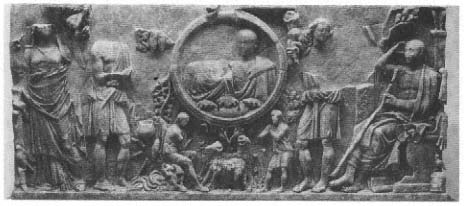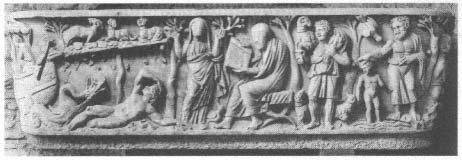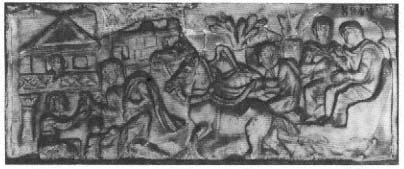The Educated Man's Search for Inner Peace
A remarkable change can be detected in the iconography of sarcophagi in the course of the second half of the third century, especially those with bucolic scenes. Whereas the amateur intellectual had previously often appeared as the zealous teacher, we now have the impression that the teaching is directed only at himself. At the same time, the earlier domestic scenes are transported to a bucolic setting in the country. One of the earliest examples, probably not much later than A.D. 250, is a recently published sarcophagus in Basel (fig. 154).[23]
The deceased couple each appear twice with portrait features: once in the central portrait medallion as a proper married couple, the husband wearing the official magistrate's toga, and again in the landscape scene, in which each personifies the values they cherish. He sits in a marble seat, holding a curved staff, and wears only the mantle that marks him as a philosopher or poet. Unlike Peregrinus, he wears no undergarment and has attributes that would suit an itinerant philosopher, yet he is definitely a layman. Despite the poor state of preservation, one can make out that the head bears portrait features and is beardless. Thus, as on other sarcophagi, he must be read as a pendant
Fig. 154
Sarcophagus of a married couple with bucolic figures. After the middle of
the third century A.D. Basel, Antikenmuseum.
to his wife, the woman in the orans pose, who likewise had portrait features.[24]
This amateur intellectual has interrupted his reading (the open book roll lies on the ground where he dropped it) and sits lost in thought. This is expressed, however, in a visual motif that is thus far unique. He holds his head high and raises one hand to his brow, as if he were looking out into the distance, or as if he were having a vision. On either side of the medallion stand a man carrying a sheep and a fisherman, while below, on a smaller scale, are two shepherds with their flock. All these bucolic elements have a long pictorial and literary tradition and would have been familiar to the contemporary viewer as symbols of the happy life.[25] The message seems to be that intellectual pursuits and the rural life confer on the individual a happiness and peace of mind comparable to that of the carefree shepherd. This is made even clearer by two complementary scenes on the short sides of the sarcophagus. In one, two philosophers, dressed as the seated figure on the front, engage in conversation, while, in the other, a herdsman pastures his sheep. On the one hand, the "philosopher" is assimilated to this bucolic world through his knotty staff and animal hide, while, on the
Fig. 155
Sarcophagus of a married couple with bucolic and biblical scenes. Late third century
A.D. Rome, Santa Maria Antiqua.
other, his carefully arranged garment and the various props (the marble seat, sundial, vine-covered pillar, and bookcase) tie him firmly to the well-tended villa where he devotes himself to his studies.
Along with the infiltration of these bucolic motifs into the world of the amateur intellectual comes frequently a changing imagery for women. The Basel sarcophagus, like others of the later third century, depicts the wife as an orans, with both arms raised. Comparison with images on coins prove that this is a symbol for piety (pietas ). The Muse has become a woman of prayer. This too, however, is a role for women that is well established in the traditions of Roman art. Julio-Claudian princesses, for example, had sometimes been shown in the same position of prayer.
Learning and the life of the mind are now presented as assisting in the search to attain inner peace and happiness. One of the earliest Christian sarcophagi, in Santa Maria Antiqua at the Roman Forum, illustrates this especially vividly (fig. 155).[26] The reader-philosopher sits in the open air beside his praying wife, framed by a man carrying a sheep and the figure of the prophet Jonah reclining under a bower (a popular image in catacomb paintings, which does not correspond to the biblical tale of Jonah but was first created in this period as a Christian version of the bucolic idyll). The baptism scene at the right edge, along with the figure of Jonah, identifies the context here as a Chris-
tian one. Hence the reading figure in the middle is most likely not studying the classics, but rather Scripture. In contrast to earlier imagery, the reader is now devoid of any ostentation. He is completely oblivious of the world around him.[27] Reading itself has become a pious activity and there is no fundamental difference between the husband's devotional reading and his wife's prayer. This is particularly well illustrated on a sarcophagus relief in the Museo Civico at Velletri.[28] The deceased woman stands in the orans pose in the center, flanked at either side by a shepherd. The space in between is filled with a patchwork of small-scale scenes from the Old and New Testaments. In one of these little scenes, right next to the orans, a philosopher sits beside a chest filled with book rolls and reads. Thus a chain of associations is created between the reading of the Scriptures, faith and prayer, and the happy condition that these lead to. The direct connection between reading and praying figures must be deliberate; it implies that the whole character of intellectual activity has changed.
Beginning in the later third century, the question was hotly debated in philosophical circles whether the wise man should withdraw from public life entirely or only on occasion, whether by means of a kind of "inner escape" within the city (there were some philosophers who no longer went out of the house) or by moving out to the country. The notion itself was not new. In the Flavian period, the Stoic philosopher Musonius Rufus had explicitly recommended the life of a peasant or shepherd to the philosophically inclined individual: "And if the tending of the flocks did Hesiod no dishonor, nor did it prevent the gods and the Muses from loving him, then neither should it anyone else. For me this is the most agreeable of all rural activities, for it offers the soul the greatest opportunities for leisure and reflection, and for the pursuit of everything we mean by paideia ."[29]
Now, however, this association between the philosopher and the pastoral life came to be seen as so desirable that it is not unusual to find a well-dressed wise man actually tending a flock of sheep or, conversely, conventional shepherds depicted with the pose and facial expression of an intellectual.[30] The very fact that such motifs were adopted so naturally into the pictorial vocabulary shows that these
metaphors for spiritual longing must have been firmly fixed in the minds of many people outside the narrow philosophical circles.
But whereas the real philosophers and, soon after, the first of the Christian hermits longed for isolated spots devoid of human contact, the amateur intellectual generally appears in scenes where he is well integrated into the life of a country estate. So, for example, the landowner might be shown on sarcophagi reading, his wife at prayer, in the midst of scenes of vintaging, the olive harvest, hunting, or a country meal. A large mosaic from a villa at Arroniz (Navarra) shows several men in contemporary dress, probably large landowners, as literati accompanied by their Muses, each against the backdrop of a villa setting. And a North African mosaic combines a bucolic scene with a villa garden and clearly labels the whole ensemble as filoso[fi?] filolocus .[31]
Naturally the age-old Roman tradition of otium and the continuing attraction of villa culture played an important role in all this.[32] But it is not enough to describe this phenomenon as simply a revival of the old idea of otium . At least in the case of some of the Neoplatonists and their followers, we are now dealing with an escape from "the world." The principal goal is to avoid any kind of disturbance so that one may focus on the interior life, tranquility of the spirit, and the search for God.[33] But even for the landowner, the path from Rome to one's country house becomes a symbolic journey into the world of the spirit. As a series of scenes on sarcophagus lids of the early fourth century illustrates, reading and discussion might begin already in the car on the journey out (fig. 156).[34]
In the time of Constantine, Aidesios of Cappadocia, a pupil of the famous Iamblichus, consulted a mystic oracle and was given a choice between a life of "undying fame" in the cities or one as a shepherd or cowherd "with the hope of union with the immortal gods," that is, a divine revelation. (Musonius, we recall, had spoken only of the search "for everything we mean by paideia .") Aidesios did actually acquire a small farmstead in the mountains of Cappadocia, but it was not long before his own pupils could persuade him to return to the philosophical schools. In the opinion of Eunapius, who records the story (VS 465), this was not the better course. It is only against the background of such hopes for divine revelation through isolation from the
Fig. 156
Fragment of the lid of a large sarcophagus, showing a man and his wife in
conversation on the way to their villa. Ca. A.D. 280. Rome, Terme Museum.
world that we can grasp the full significance of the visionary gestures of the "philosopher" on the Basel sarcophagus or the many orans figures directing their admonition straight at the viewer.


